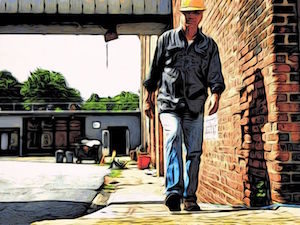The Fire Next Time
Only You Can Question a Talking Bear

Smokey the Bear causes forest fires. Well, he sort of makes them worse.
I'm only half joking here. In the early 1900s, forest fire prevention and firefighting policies specifically campaigned to suppress all fires and we got very, very good at it.
Smokey the Bear, introduced in 1944, was an effective part of the campaign. The problem with all of the fire fighting, though? Undergrowth started to build up.
As it turns out, ecosystems have actually evolved to deal with fires. For example, many trees actually require fire in order to sprout their seeds. Which means that we “need” regular forest fires in order to clear out undergrowth, so that new growth can fill in.
If that undergrowth isn't cleared out—say, due to people preventing forest fires for decades—when a fire finally does occur, it's likely to be a full crown fire, instead of a relatively harmless and beneficial ground fire. A crown fire is one that grows large enough to burn material up in the tops of trees and completely wipes out all vegetation in a region.
This can lead to massive surface erosion, wildlife die-offs, alteration of surface chemistry, and many other negative consequences. Some crown fires can grow large enough to become firestorms, which create their own wind systems.
Here's a crown fire:
For comparison, here are the aftereffects of a ground fire, in time lapse:
Since the 1960s, though, scientists have recognized and begun pushing steps to correct the problem. Controlled burns have become much more common in the decades since, and the expenses involved in running them safely are more than recouped by the lack of damages from much larger, more dangerous fires.
So, Smokey the Bear did develop from a wrong-minded way of looking at wildfire control, but he still does serve one important purpose: controlled burns need to be started by professionals. If you're camping in the woods, be careful with your fires.
_________
Quotable
Oh, Yard Ramp Guy, only you can prevent bad quotations:
“The grass is always greener around the fire hydrant.”
— Jeff Rich
Roads as History
Beware the Golden Cow

I write a lot about roads on this blog. The Yard Ramp Guy must think I'm a bit obsessed (though he’d probably phrase it differently).
The study of roads is the study of history. Countless historical events, from the outcomes of wars to international trade, and from religious expansion to the maintenance of nations: they all rely on roads.
Incan roads—not the most extensive network of ancient roads but one of the most technologically impressive—were earthquake-proof with incredibly durable suspension bridges. Roman roads have been receiving acclaim for millennia now, and many are still in use.
Which brings us to ancient Chinese roads.
Under the Qin Dynasty (circa 220 BC), Chinese road networks were considerably more extensive than their Roman contemporaries. One, the Ancient Road of Mules and Horses, was created in 214 BC by an advancing army of the Qin. The Emperor marched a half-million strong army in a straight line on one of his wars of conquest, crushing the earth in its path. They later covered the road in slate, and it remained in use for 2,000 years afterward without changing routes.

Walking up a golden ramp. Kind of.
Road maintenance was key in holding onto territory in China. Later dynasties, like the Han, went to great pains to maintain this and other roads, building hostels and post offices along their lengths. Another Qin road was immensely long, built to service border forts along a huge wall that predated the Great Wall.
My favorite ancient road of all, though, is the Stone Cattle Road. One of the ancestors of the First Qin Emperor wanted to conquer the nearby Shu kingdom to the south, over the Qinling Mountains. He had his sculptors and artisans carve five life-sized stone cows and decorate their tails and hindquarters with gold.
When the king of Shu received news of them, he asked the Qin king to send him a herd. The Qin king claimed that he would need a gallery road (built of wooden planks imbedded in the sides of cliffs) across the mountains to move the cows. The Shu king not only permitted it; he also helped fund the construction.
Yes, we know how this story develops: The first thing the Qin king brought over wasn't a herd of gold-depositing cattle. He brought an army.
_________
Quotable
Oh, Yard Ramp Guy, the road to great quotations is paved with good intentions:
“Roads are long: make them short with a good company!”
— Mehmet Murat ildan
Of a Certain Age
Or: Smelt This.
 We’ve heard of the Stone Age, the Bronze Age, and the Iron Age. And yet, we aren't commonly taught why those ages occurred in that order. Which is just too bad, since it's pretty darn interesting.
We’ve heard of the Stone Age, the Bronze Age, and the Iron Age. And yet, we aren't commonly taught why those ages occurred in that order. Which is just too bad, since it's pretty darn interesting.
The Stone Age has a simple explanation. Stone is easier to work than metal, and more common. We figured out how to use it first.
Ancient humans actually did master use of some metal during this time period— namely meteoric iron, a natural alloy of nickel and iron present in iron meteorites. We sometimes heated it but more often shaped it, by cold hammering, into tools and arrowheads; the stuff was quite difficult to work.
The ancient Inuit inhabitants of Greenland, though, used iron much more extensively than other Stone Age people. Greenland has the world's only major deposit of telluric iron, also called native iron, which is iron that occurs in its pure metal state.

Looking for the right tool to advance our evolution
Native copper, however, is found worldwide (as are native gold, silver, and platinum, all of which are of limited use for tools.) The hardest and strongest common native metal on Earth, copper proved one of the most useful.
Eventually we learned to smelt metals from ore and, around 2500 BC, learned to alloy the two together to make bronze, kicking off The Bronze Age. Tin was somewhat rare outside the British Isles, parts of China, and South Africa, so it actually ended up commanding prices higher than gold in many regions. We frequently used zinc, more common than tin, to produce brass.
Iron smelting first occurred circa 1800 BC but didn't become common until 1200 BC. Eventually, of course, iron became the metal of choice for civilization—it's just much stronger than most of the other options.
_________
Quotable
Oh, Yard Ramp Guy, and I quote:
“Stone Age. Bronze Age. Iron Age. We define entire epics of humanity by the technology they use.”
— Reed Hastings
Improving Traffic Flow
Or: It’s Zippier with a Zipper.
All traffic isn't created equal.
 For example, you've likely noticed that the morning rush hour often has greater traffic coming into the city from the suburbs and that the evening rush hour traffic clogs up the outbound lanes.
For example, you've likely noticed that the morning rush hour often has greater traffic coming into the city from the suburbs and that the evening rush hour traffic clogs up the outbound lanes.
So, we tend to have traffic moving much more slowly in one direction than the other.
Accidents and our tendency to rubberneck them also cause the traffic to bunch in one direction. (Yes, we can keep listing these reasons for a while.) Unfortunately, building new lanes for our roadways can be prohibitively expensive, and it often isn't even possible, especially where bridges are concerned.
There is a fascinating solution, though:
Road zippers are heavy vehicles that have the ability to move concrete lane dividers across a lane, widening the road for one direction of traffic, narrowing it for the other. This requires a special type of moveable barrier, with shorter segments linked together by flexible steel connectors.
The road zipper, plus new barriers, are far, far cheaper than an entirely new lane. They actually pick up the segment lines using a little conveyor system, essentially acting on the same principles as a screw or a ramp (though Jeff Mann, The Yard Ramp Guy, might think I'm stretching that definition a bit).
Road zippers can move the lane at up to a top speed of 10 mph, depending on traffic, and is much safer than trying to manage traffic with cones and lights. They're especially useful on bridges. Crews on the Golden Gate Bridge have been employing a road zipper since 2010 to manage rush hour traffic, to great effect.
Any road crew that's worked on a bridge isn't going to have particularly fond memories of dealing with bridge traffic, and the road zipper provides an effective solution. We can also use this method to speed up bridge re-decking projects, moving the barrier to protect the work zone.
Transportation authorities utilize road zippers all around the world, and they're especially popular in the United States and Australia. Many cities use them on a permanent basis, while others lease them temporarily during construction work.
Even if they weren't so useful logistically, I'd still like them: they're just plain cool.
_________
Quotable
Oh, Yard Ramp Guy, while I like your sports quotes (go, team), I tend to stay on topic:
“If you don’t know where you are going, any road will get you there.”
— Lewis Carroll





